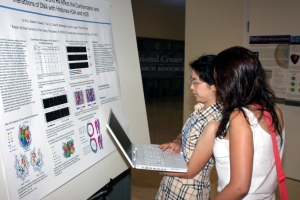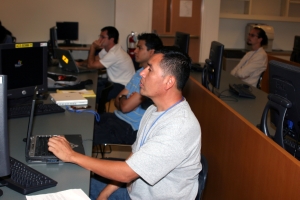Summer Institute 2006: Understanding the Role of Cyberinfrastructure in Biomedical Research
San Diego, CA, August 11, 2006 -- The National Biomedical Computation Resource (NBCR) hosted its first ever Summer Institute this week at Atkinson Hall, home of the UCSD division of Calit2. The subject of the week-long training program was "Cyberinfrastructure and Multiscale Modeling Approaches."
|
NBCR's Summer Institute 2006 is the first of what will become an annual event bringing together cyberinfrastructure and computational modeling experts, tool developers and biomedical researchers to discuss and learn about available tools and resources, how to use them, how to improve them and what else is needed. In this process of integration and collaboration, they will shape and improve the present and future of biomedical research.
"We are now able to take advantage of all the emerging and developing technologies and change the way we do science," said NBCR director Peter Arzberger, who is an active participant in Calit2.
The use of cyberinfrastructure and grid computing has already become crucial to cutting edge science. "It is not just good to have, but essential," said UCSD physicist Frank Würthwein, a researcher in the field of experimental elementary particle physics. He is also one of the two application coordinators for the Open Science Grid.
"We are in the process of commissioning a new experimental instrument that will provide a three orders of magnitude increase in physics sensitivity," explained Würthwein, who is quite excited about "this huge once-in-a-lifetime opportunity." "It will take a decade or two to fully exploit this data." But, he cautioned, "this experimental program will fail without stable, reliable grid computing."
The week-long training program began with a day of plenary sessions in the Atkinson Hall auditorium. A live webcast of Monday's presentations was available on the Calit2 web site. These plenary talks are now available for on-demand viewing over the Internet; to view any of the nine talks, click here . Additional information on the courses and plenary sessions are available on the Summer Institute's wiki, blog and webpages (links are below).
|
Three of the four speakers during the morning plenary session were Calit2 affiliated researchers. Mark Ellisman is the director of UCSD's Center for Research in Biological Structure (CRBS). His presentation provided an in-depth look at cyberinfrastructure and multiscale modeling including the issue of scale. Multiscale modeling in biomedical research involves the investigation of systems at different scales -- single molecules, macromolecule complexes, cells, tissues and organs. The 'tyranny of scale' means that some problems will require many generations before we have enough computing power to solve them.
Philip Papadopoulos is a Coordinating Center co-investigator for the Biomedical Informatics Research Network (BIRN); he presented on the "Anatomy of the BIRN." Ellisman and Papadopoulos are co-principal investigators on Calit2's OptIPuter project, as well as researchers with NBCR. Paul Gilna discussed Calit2's metagenomics project - CAMERA, of which he is the executive director.
NBCR´s goal for the Summer Institute is to broaden the impact and use of available tools and collaborate with the biomedical community in future developments. The plenary sessions on Monday served as a mini-symposium on the subject at hand. The morning presentations centered on cyberinfrastructure and the afternoon session was on multiscale modeling approaches.
|
The afternoon plenary session featured two UCSD academic researchers presenting their multiscale applications research. Andrew McCulloch of the Jacobs School of Engineering discussed his work on cardiac systems biology. Andrew McCammon presented on "Continuum Models for Electrostatics and Diffusion. "They are members of NBCR and along with other researchers, provide the scientific driver for us to develop the cyberinfrastructure," noted Wilfred Li, the executive director of NBCR and co-organizer of the Summer Institute. Several of the tools presented have been developed and/or facilitated by NBCR.
Biomedical researchers should not have to be computational or grid experts. One of the recurring themes was that whatever the tool or resource, the goal is to make it transparent to the user. "All the different modules can be developed independently, but can be put together using a standardized interface creating a comprehensive environment," explained NBCR's Li.
Four days of hands-on training sessions followed Monday's mini-symposium. There were six different tracks: three on cyberinfrastructure and three on multiscale modeling. The course tracks were: Cluster and Grid Computing, Web Services and Ontology, Molecular Visualization and Virtual Screening, Computational Cardiac Electrophysiology and Mechanics, Molecular Electrostatics And Diffusion and Gridsphere Portals. The morning and afternoon sessions were aligned such that participants could choose to attend tracks in both areas.
"The mission of NBCR is to give biomedical researchers transparent access to this world of distributed computing: the data, the visualizations and the people," Arzberger explained. Arzberger was co-organizer of the Summer Institute and is also director of Life Science Initiatives at UCSD.
|
Nearly 100 researchers in all participated in the Summer Institute. About half of them participated as session chairs, guest speakers and lecturers; some 50 took the training courses. They came from universities and organizations throughout the U.S. and across the globe (Canada, China, Finland, Great Britain, Japan, Portugal and Mexico). Many participants were from another Calit2 affiliated activity, the Pacific Rim Application and Grid Middleware Assembly (PRAGMA), which is principally funded by the National Science Foundation (NSF).
"Reflecting the themes of the inaugural Summer Institute," summarized Arzberger, "the diversity of the participants demonstrates the international nature of science, and sets the stage for broader collaborations among the participants and their colleagues."
"The purpose of NBCR is to help the broader research community, who are not experts in these areas, utilize powerful new approaches," explained Michael Marron, who is the director of Biomedical Technology for the National Center for Research Resources (NCRR) of the National Institutes of Health (NIH), which funds NBCR.
Marron continued: "I think this workshop is a good example of facilitating more rapid use of these technologies. The sessions are an interesting combination - not only describing the tools and infrastructure, but also describing the uses. The ability to promote this kind of interaction is a central feature to why NIH funds NBCR."
|
Related Links
NBCR Summer Institute 2006
National Biomedical Computation Resource (NBRC)
NBRC Summer Institute 2006 Forum
NBRC Summer Institute 2006 Wiki
Biomedical Informatics Research Network (BIRN)
CAMERA
Center for Research in Biological Structure (CRBS)
OptIPuter
Pacific Rim Applications and Grid Middleware Assembly (PRAGMA)





